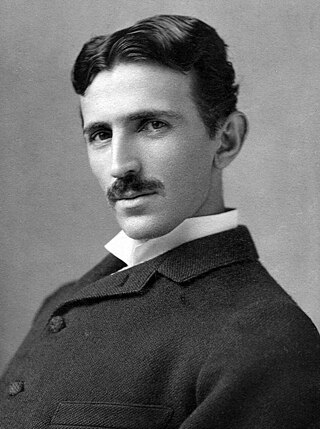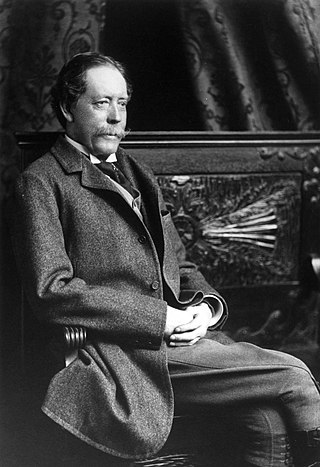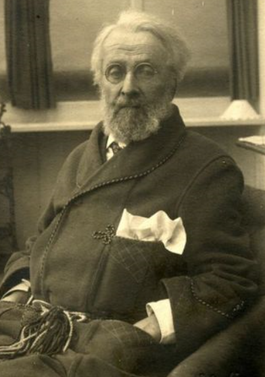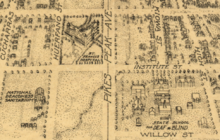
Nikola Tesla was a Serbian-American inventor, electrical engineer, mechanical engineer, and futurist best known for his contributions to the design of the modern alternating current (AC) electricity supply system.

William Jackson Palmer was an American civil engineer, veteran of the Civil War, industrialist, and philanthropist. During the American Civil War, he was promoted to brevet brigadier general and received a Medal of Honor for his actions.

The Tesla Experimental Station was a laboratory in Colorado Springs, Colorado, USA built in 1899 by inventor Nikola Tesla and for his study of the use of high-voltage, high-frequency electricity in wireless power transmission. Tesla used it for only one year, until 1900, and it was torn down in 1904 to pay his outstanding debts.
The International Typographical Union (ITU) was a US trade union for the printing trade for newspapers and other media. It was founded on May 3, 1852, in the United States as the National Typographical Union, and changed its name to the International Typographical Union at its Albany, New York, convention in 1869 after it began organizing members in Canada. The ITU was one of the first unions to admit female members, admitting women members such as Augusta Lewis, Mary Moore and Eva Howard in 1869.

The Colorado School for the Deaf and Blind (CSDB) is a K-12 residential school, located on Knob Hill, one mile (1.6 km) east of downtown Colorado Springs, Colorado, near the famous laboratory of Nikola Tesla. The school was founded in 1874 as The Colorado Institute for the Education of Mutes by Jonathan R. Kennedy, who had previously been steward at the Kansas State School For the Deaf. The school began in a rented house in downtown Colorado Springs with seven students, three of whom were Kennedy's own children. One of his children, Emma, later married another student, Frank H. Chaney, and they became the parents of the actor Lon Chaney.

Before it was founded, the site of modern-day Colorado Springs, Colorado, was part of the American frontier. Old Colorado City, built in 1859 during the Pike's Peak Gold Rush was the Colorado Territory capital. The town of Colorado Springs, was founded by General William Jackson Palmer as a resort town. Old Colorado City was annexed into Colorado Springs. Railroads brought tourists and visitors to the area from other parts of the United States and abroad. The city was noted for junctions for seven railways: Denver and Rio Grande (1870), Denver and New Orleans Manitou Branch (1882), Colorado Midland (1886-1918), Colorado Springs and Interurban, Atchison, Topeka, and Santa Fe (1889), Rock Island (1889), and Colorado Springs and Cripple Creek Railways. It was also known for mining exchanges and brokers for the Cripple Creek Gold Rush.
George W. Hindman was a 19th-century American cowboy and law enforcement officer serving as a deputy sheriff of Lincoln County, New Mexico, during the early months of the Lincoln County War.

Tesla's electro-mechanical oscillator is a steam-powered electric generator patented by Nikola Tesla in 1893. Later in life Tesla claimed one version of the oscillator caused an earthquake in New York City in 1898, gaining it the popular culture title "Tesla's earthquake machine".
The Convention of American Instructors of the Deaf (CAID) is an "organization for all teachers, administrators, educational interpreters, residential personnel, and other concerned professionals involved in education of the deaf.". The CAID held its first convention on August 28, 1850, in New York City, New York, at Washington Heights. The second Convention was held the next year, in 1851, in Hartford, Connecticut and the third Convention was held two years after that, in 1853, in Columbus, Ohio. The fourth Convention met in 1856 in Staunton, Virginia. The Convention continued to meet every couple of years, then became formally incorporated during its Fourteenth meeting, in 1895, in Flint, Michigan.
José Mariano Chaves y Castillo was a wealthy Spanish-American landowner who was the acting governor of New Mexico for a few months during 1844. Chaves County, New Mexico is named after him.
Gervasio Cruzat y Góngora was Governor of New Mexico between 1731 and 1736 at a time when it was a province of New Spain, as well as governor of Presidio of Pensacola, in Florida, between 1740 and 1742. He assisted the bishop of Durango, taking evidence for him in his contest with the Franciscans.

The Antlers is a Wyndham Hotel located in Colorado Springs, Colorado. It opened in 1967 and is the third hotel of that name on the same site.
Roswell, now annexed into the city of Colorado Springs, Colorado, was a coal mine settlement near the northern bluffs of Colorado Springs and a 19th-century railroad junction. The town was located at roughly the present intersection of Fillmore Street and North Nevada Avenue in Colorado Springs.

Pikeview is a neighborhood of Colorado Springs, annexed to the city as the "Pike View Addition" on August 1, 1962. In 1896 there was a Denver and Rio Grande Western Railroad station in Pikeview, and miners had begun digging a shaft for the Pikeview Coal Mine. Pikeview also had a quarry beginning 1905 for the mining of limestone for concrete. Coal mining ended in 1957, but the Pikeview Quarry continues to operate. Quarry operations, though, have created a gash or scar in the landscape and efforts have been made since the late 1980s to reclaim the hillside landscape. The Greg Francis Bighorn Sheep Habitat in what had been Queens Canyon Quarry was founded in 2003 in recognition of the individuals and organizations that have worked to create a nature hillside habitat.
The town of Colorado Springs, Colorado played an important role in the history of tuberculosis in the era before antituberculosis drugs and vaccines. Tuberculosis management before this era was difficult and often of limited effect. In the 19th century, a movement for tuberculosis treatment in hospital-like facilities called sanatoriums became prominent, especially in Europe and North America. Thus people sought tuberculosis treatment in Colorado Springs because of its dry climate and fresh mountain air. Some people stayed in boarding houses, while others sought the hospital-like facilities of sanatoriums. In the 1880s and 1890s, it is estimated that one-third of the people living in Colorado Springs had tuberculosis. The number of sanatoriums and hospitals increased into the twentieth century. During World War II, medicines were developed that successfully treated tuberculosis and by the late 1940s specialized tuberculosis treatment facilities were no longer needed.
The following is a timeline of the history of the city of Colorado Springs, Colorado, USA.

Edith Mansfield Fitzgerald (1877–1940) was a deaf American woman who invented a system for the deaf to learn proper placement of words in the construction of sentences. Her method, which was known as the 'Fitzgerald Key,' was used to teach those with hearing disabilities in three-quarters of the schools in the United States.
Santa Barbara is a former settlement in Dona Ana County, New Mexico, now the site of Hatch, New Mexico. It lay at an elevation of 4,058 feet / 1,237 meters.

Nikola Tesla patented the Tesla coil circuit on April 25, 1891. and first publicly demonstrated it May 20, 1891 in his lecture "Experiments with Alternate Currents of Very High Frequency and Their Application to Methods of Artificial Illumination" before the American Institute of Electrical Engineers at Columbia College, New York. Although Tesla patented many similar circuits during this period, this was the first that contained all the elements of the Tesla coil: high voltage primary transformer, capacitor, spark gap, and air core "oscillation transformer".

Montague Richard Leverson was a British lawyer who emigrated to the US, where he was a rancher in Colorado, and lawyer and politician in California. Leverson was also a homeopathic physician, anti-vaccinationist and germ theory denialist.













